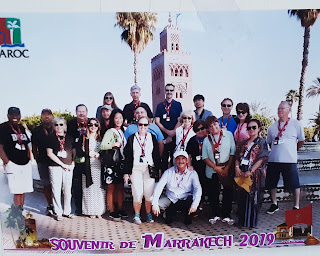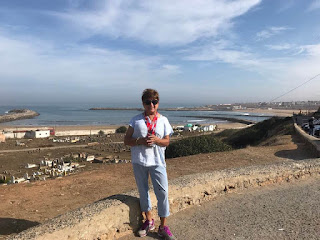September 18 to 26, 2019: MOROCCO!
 |
Andy and me on our Moroccan adventure, here with
new friends Peg and Ken from Boston on a carriage ride
through the streets of Marrakesh to a popular restaurant. The food was fabulous. |
 |
| The beauty of Morocco |
 |
Traditional Moroccan tea pot.
We had many cups of tea. |
Morocco! The name evokes the sights, colors, and sounds of an exotic place. Casablanca, Fez, Marrakesh! My sister Andy and I were on a whirlwind tour of this magical Saharan kingdom in north Africa, a dream fulfilled. It was a Gate 1 tour. Our tour manager was Ibrahim Aghraz, a Moroccan who loves his country and shared it with us enthusiastically, as only a native can. A Gate 1 professional, he paid meticulous attention to every detail, connected with our city tour guides, all of whom were excellent, and led us on paths of discovery and enlightenment. The tour bus was new, big, comfortable, and the bus driver friendly and skillful. Everyone associated with the tour was helpful. We were fortunate to be with a fantastic group of people as well, diverse, all ages, from all over the USA.

We actually met our first new friends at the Paris airport while waiting for our flight to Casablanca.They were looking at Morocco maps; we asked if they were going on the Gate 1 tour. They were indeed! So we met Peg and Ken, retired teachers and world travelers from Boston. We stuck together once we got to Morocco, made more friends, shared wonderful times together. Short and sweet is the best way for me to travel these days, getting the highlights of a place, a taste of the history and culture, the natural and built environments, the activities of the people on the streets, at palaces and temples, in the Souks, the ever-present vendors selling their trinkets, leather, jewelry, souvenirs, taking every opportunity to make a living.
 |
A grid collage of an assortment of photos taken in Rabat and at Volubilis. They are a way to remind me of
the sights and spirit of the places we visit. Memory collages. |


We arrived in Morocco via Casablanca, but our first destination was Rabat, the capital. We would return to Casablanca at the end of our tour. Rabat is a pretty city on the shores of the Bouregreg River and the Atlantic. It's known for landmarks that reflect its Islamic and French-colonial heritage, including the Kasbah of the Udayas. The Berber-era royal fort is surrounded by formal French-designed gardens, a melange of cultures, a mixed heritage. The iconic Hassan Tower, a 12th-century minaret, soars above a mosque that was never finished. We walked around the Royal Palace, decorated with exquisite tile work that is a hallmark of Moroccan art and craftsmenship everywhere. We visited the ruins of Chella, where wild purple morning glories sprouted out of old ruins and feral cats roamed peacefully, so pretty and, we learned, ubiquitous. Ibrahim said the authorities were dealing with the problem, but it was hard keeping up with all those cats. We could see that! I loved the Oudaya Kasbah, beautiful in blue and white, like a painting.

Enroute from Rabat to Fez, we stopped at the ruins of the ancient Roman city of Volubilis. The tour guide was a real scholar, full of information. We could survey the whole city layout, walk the Roman road and ancient paths, admire wonderfully preserved rooms and original mosaics. Those Romans were everywhere, and they built for the ages.
 |
| Andy at Rabat Royal Palace. |
Ibrahim regaled us with the history of Morocco as we traveled
 |
| From Marrakesh with love |
between city sites. This lovely north African country, we learned, is distinguished by its Berber, Arabian and European (mostly Spanish Muslim and French) cultural influences. It's a constitutional monarchy, headed by King Mohammed VI of the Alaouite Dynasy, which goes back to the 17th century. When democracy movements spread across northern Africa in 2011, King Mohammed stepped up to implement reform programs. They included a new constitution, which was passed by popular referendum in July 2011. It extended new powers to Parliament, which is now controlled by the Justice and Development Party, a moderate Islamist party. Ibrahim seemed to see the King as a benevolent and wise monarch, forward thinking, working with the Parliament to take Morocco into a bright future. We all hoped this was so, making Morocco a beaming light in north Africa.
 |
Our wonderful Fez guide,
leading us down alleyways
and behind closed doors. |
Ibrahim stressed throughout the tour, every chance he got, that while is Morocco is an Islamic country, all religions are welcomed and tolerated. Many refugees from war-torn countries have made their way here, and help is available. Ibrahim made sure our tour included visits to Islamic, Christian and Jewish sites. The best part was experiencing this diversity and tolerance first hand as we sipped tea at cafes and wandered the streets, alleyways and byways of Rabat, Fez, Marrakesh and Casablanca.

There's no place like the Medina of Fez to absorb the richness and textures of Moroccan culture. The old city is a fascinating labyrinth of ancient pathways, cobble-stoned streets, narrow and winding alleyways, all within an incredibly complex maze that doesn't seem to have a beginning or an end. Our city guide knew how to get around, though. It was impressive. We made sure to follow him closely for fear of getting lost in a place we couldn't even describe. Some of us wondered, jokingly, if our GPS would work. But there are indeed destinations: homes, cafes and restaurants, shops, tons of shops, all selling an incredible variety of goods and wares, arts and crafts. There were lots of surprises behind the doors that faced the alleys: ordinary homes, grand homes fit for a king, wonderful restaurants (we lunched at one of them), small businesses, like the argan oil place where we were sold a bill of goods, and happily so.


A favorite was the rug merchants. Our tour guide opened a door onto a palace of

enormous rooms with carved columns, exquisite tiles, marble and gold, the home and business of a carpet
merchant and his wife. We sipped hot mint tea and sat through a brilliantly orchestrated presentation of hundreds of rugs, one more beautiful than the other. We were mesmerized. It's hard not to blow caution to the wind under the influence of such awesome and practiced salesmanship. The workers did their job. After all that, I was glad some members of our group actually bought rugs. Those rugs, I thought, would take them on magic carpet rides, and last a lifetime.


 After Fez we arrived in Marrakesh (also spelled Marrakech). It's a beautiful city, an oasis in the desert since neolithic times and Berber farmers, although the city itself was founded in 1062. I was entranced by the colors, patterns and light of Marrakesh, still dancing in my head. From the lovely balcony of our hotel, Andy and I, vodka and tonic in hand at the end of the day, enjoyed the palm trees swaying against azure blue skies. We were surrounded by the city's richly adorned architecture with graceful Islamic curves, brilliant tile work, fascinating details. The city itself is surrounded by red sandstone walls and structures, madrasas (Koranic schools) and mosques, built by Almoravid king Yusuf ibn Tashfin in the 12th century. Marrakesh is the "Red City," with the iconic Koutoubia Minaret towering over it. It's also a city of palaces, few more stunning than the Bahia Palace with its incredible carved cedar ceilings and stunning piazza.
After Fez we arrived in Marrakesh (also spelled Marrakech). It's a beautiful city, an oasis in the desert since neolithic times and Berber farmers, although the city itself was founded in 1062. I was entranced by the colors, patterns and light of Marrakesh, still dancing in my head. From the lovely balcony of our hotel, Andy and I, vodka and tonic in hand at the end of the day, enjoyed the palm trees swaying against azure blue skies. We were surrounded by the city's richly adorned architecture with graceful Islamic curves, brilliant tile work, fascinating details. The city itself is surrounded by red sandstone walls and structures, madrasas (Koranic schools) and mosques, built by Almoravid king Yusuf ibn Tashfin in the 12th century. Marrakesh is the "Red City," with the iconic Koutoubia Minaret towering over it. It's also a city of palaces, few more stunning than the Bahia Palace with its incredible carved cedar ceilings and stunning piazza.  That's how I happened upon what seemed to be an ancient home, perhaps a mosque, I couldn't tell, squeezed unceremoniously between new modern buildings, almost completely hidden from sight. I was on a walk, exploring. As I neared our hotel, I saw it: this crumbled structure with few walls but remnants of traditional Islamic arches, fabulous tiles and craftsmanship, beautiful weaving, columns, decorated arches, exquisite tiles on remaining walls, decorated fountains. The site looked slated for demolition. Piles of cement blocks filled one corner. I hesitated, walked in, moved slowly about the lovely site, noting every detail. It seemed abandoned.
That's how I happened upon what seemed to be an ancient home, perhaps a mosque, I couldn't tell, squeezed unceremoniously between new modern buildings, almost completely hidden from sight. I was on a walk, exploring. As I neared our hotel, I saw it: this crumbled structure with few walls but remnants of traditional Islamic arches, fabulous tiles and craftsmanship, beautiful weaving, columns, decorated arches, exquisite tiles on remaining walls, decorated fountains. The site looked slated for demolition. Piles of cement blocks filled one corner. I hesitated, walked in, moved slowly about the lovely site, noting every detail. It seemed abandoned.
































No comments:
Post a Comment